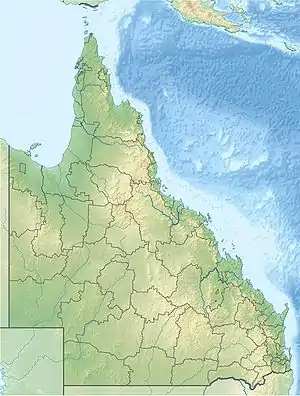South Cumberland Islands National Park
South Cumberland Islands is a national park in Queensland, Australia, 831 km northwest of Brisbane. It is famous for the marine stingers which can be found in the waters of the park between October and May.[1]
| South Cumberland Islands National Park Queensland | |
|---|---|
 South Cumberland Islands National Park | |
| Nearest town or city | Mackay, Queensland |
| Coordinates | 20°44′28″S 149°28′25″E |
| Area | 21.8 km2 (8.4 sq mi) |
| Managing authorities | Queensland Parks and Wildlife Service |
| Website | South Cumberland Islands National Park |
| See also | Protected areas of Queensland |
Islands
Islands that are protected within the park include (portion of) Keswick Island, St Bees Island, Cockermouth Island, and Scawfell Island (formerly named L Island), which is the largest in the group.
Scawfell Island
Scawfell Island (located at 20°52'S., 149°37'E., 60 kilometres (37 mi) off the cost of Queensland, north-east of Mackay) is officially regarded as the beginning of the Whitsunday group. It was originally part of the Cumberland Isles Group identified by Captain James Cook in 1770, but was not named. The island is one of the Cumberland Isles, later known as Whitsundays, and is now part of the South Cumberland Islands. It was named "L Island" by Matthew Flinders in September 1802, during his circumnavigation of Australia in Investigator. It was later renamed as Scawfell Island in 1879, by Staff Commander E. P. Bedwell of the Royal Navy, who surveyed and named many islands of the Whitsundays in 1879 in SS Llewellyn. The name of the island originates from England's second highest peak, Scafell, in Cumbria, which was then spelt "Scawfell".[2]
The terrain of the island rises to a peak 397 metres (1,302 ft) high, south-east of Duddon Point, the northern extremity of the island. The island lies and is a large horseshoe shape, with granite cliffs along the coast. It is the largest national park island in the South Cumberland group, and is uninhabited. Large areas of tropical rainforest cover steep mountain slopes. There is a coral fringing reef.
Refuge Bay on Scawfell Island provides good anchorage and fishing is permitted here.[1] Bush camping is permitted on Scawfell Island but visitors must be self-sufficient, and a permit is required from Queensland National Parks. Camping is at sheltered sites in Refuge Bay.[3]
In February 2023, a report[4][5] by Dr Conrad Hoskin reported the finding of the Scawfell Island leaf-tailed gecko (Phyllurus fimbriatus), growing to 15 cm.
St Bees Island
St Bees Island is the 2nd largest island in the group 10.32 km2 (3.98 sq mi), and is populated by a family living at Homestead Bay on the island.
References
- Explore Queensland's National Parks. Prahran, Victoria: Explore Australia Publishing. 2008. p. 17. ISBN 978-1-74117-245-4.
- Wainwright, A. (1960). The Southern Fells. London: Francis Lincoln. ISBN 0-7112-2230-4.
- Science, jurisdiction=Queensland; sector=government; corporateName=Department of Environment and (22 October 2009). "Refuge Bay, Scawfell Island | South Cumberland Islands National Park". Parks and forests | Department of Environment and Science, Queensland. Retrieved 17 February 2021.
{{cite web}}: CS1 maint: multiple names: authors list (link) - A new species of Phyllurus leaf-tailed gecko (Lacertilia: Carphodactylidae) from Scawfell Island, mid-east Queensland, Australia, Conrad J Hoskin, Zootaxa, 2023-02-20
- New species of leaf-tailed gecko discovered on Scawfell Island in Great Barrier Reef, Julius Dennis, ABC News Online, 2023-03-03